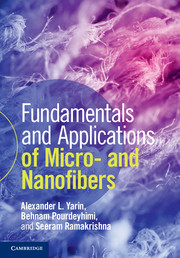Book contents
- Frontmatter
- Contents
- Preface
- 1 Introduction
- 2 Polymer physics and rheology
- 3 General quasi-one-dimensional equations of dynamics of free liquid jets, capillary and bending instability
- 4 Melt- and solution blowing
- 5 Electrospinning of micro- and nanofibers
- 6 Additional methods and materials used to form micro- and nanofibers
- 7 Tensile properties of micro- and nanofibers
- 8 Post-processing
- 9 Applications of micro- and nanofibers
- 10 Military applications of micro- and nanofibers
- 11 Applications of micro- and nanofibers, and micro- and nanoparticles: healthcare, nutrition, drug delivery and personal care
- Subject Index
- References
6 - Additional methods and materials used to form micro- and nanofibers
Published online by Cambridge University Press: 05 June 2014
- Frontmatter
- Contents
- Preface
- 1 Introduction
- 2 Polymer physics and rheology
- 3 General quasi-one-dimensional equations of dynamics of free liquid jets, capillary and bending instability
- 4 Melt- and solution blowing
- 5 Electrospinning of micro- and nanofibers
- 6 Additional methods and materials used to form micro- and nanofibers
- 7 Tensile properties of micro- and nanofibers
- 8 Post-processing
- 9 Applications of micro- and nanofibers
- 10 Military applications of micro- and nanofibers
- 11 Applications of micro- and nanofibers, and micro- and nanoparticles: healthcare, nutrition, drug delivery and personal care
- Subject Index
- References
Summary
This chapter covers several additional methods used to form micro- and nanofibers. Some of them have already achieved maturity, such as the island-in-the-sea method discussed in Section 6.1, melt fracture in meltblowing processes (Section 6.2) and the flash spinning process (Section 6.3). Some others are still relatively exotic or under development, like the two methods based on Couette shear flow described in Section 6.4, or the centrifugal spinning method in Section 6.5. Nontraditional materials used for nanofiber formation, discussed in Section 6.6, include liquid crystals, conducting polymers, biopolymers and denatured proteins. Finally, Sections 6.7 and 6.8 discuss the specifics of drawing glass optical fibers, and in particular, polarization-maintaining optical fibers with multilobal cladding (Section 6.8).
Island-in-the-sea multicomponent fibers and nanofibers
Microscopic bi- and multicomponent fibers can be formed using melt spinning (Section 1.2 in Chapter 1), meltblowing (Section 4.1 in Chapter 4), or integrated processes such as spunbonding (Section 1.5 in Chapter 1). The additional polymer components are supplied to the main polymer through separate inner spinnerets inserted into the main outer spinneret similarly to formation of core–shell bicomponent fibers in co-electrospinning (Section 5.8 in Chapter 5) and solution blowing (Section 4.8 in Chapter 4). Cross-sections of such bi- and multicomponent fibers are reminiscent of islands in the sea, which explains the name of this technology (Nakajima 2000). In some cases the islands can merge and form winged structures, as seen in Figure 6.1a.
Information
- Type
- Chapter
- Information
- Fundamentals and Applications of Micro- and Nanofibers , pp. 262 - 296Publisher: Cambridge University PressPrint publication year: 2014
